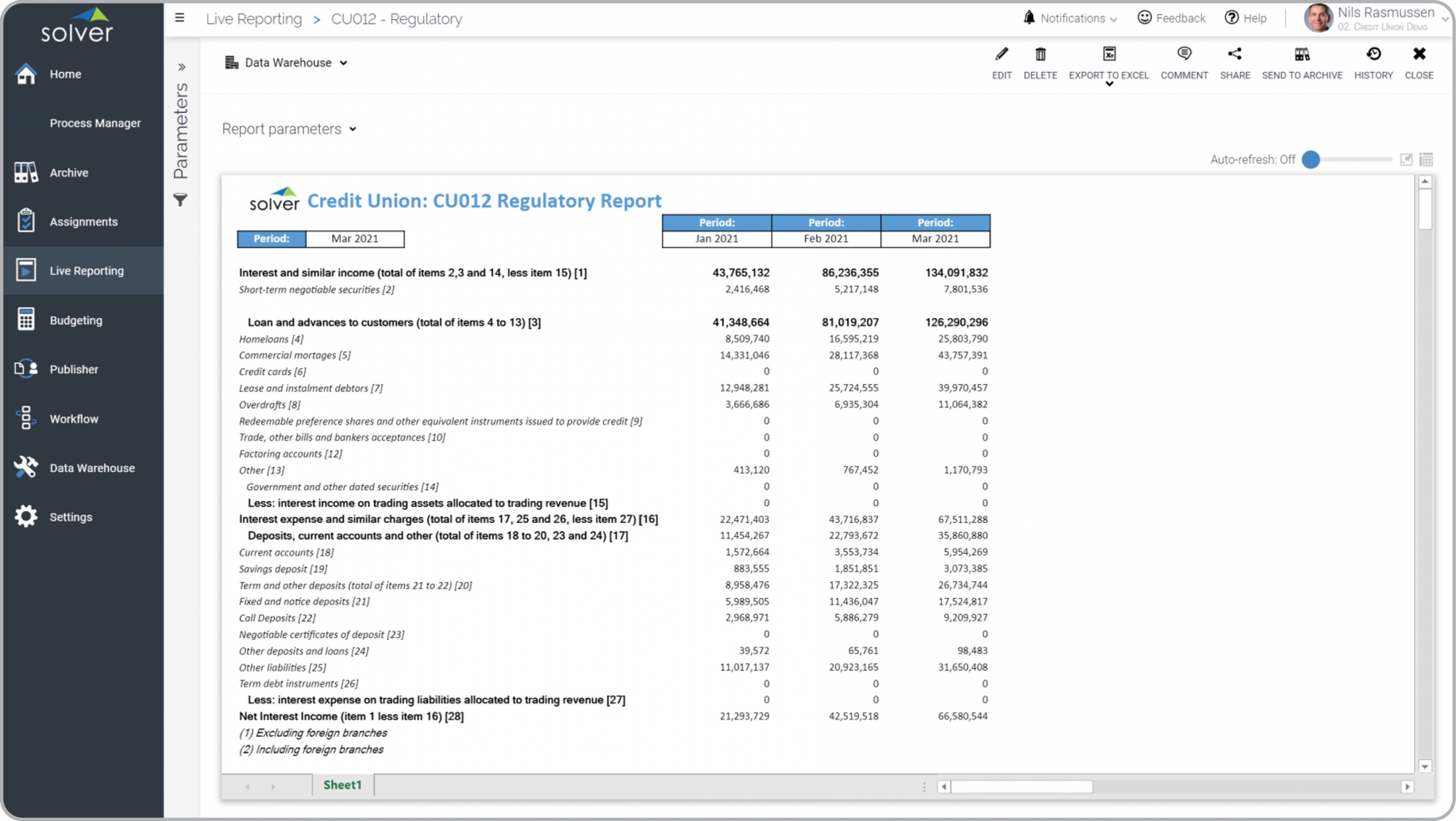Trended Regulatory Report for Credit Unions
What is
a
Trended Regulatory Report
? Trended Regulatory Report are considered government compliance reports and are used by Accountants, CFOs, Controllers and Compliance Reporting Managers to provide key financial metrics in a specific reporting format. Some of the main functionality in this type of compliance report is that it is a standard format that populates automatically based on the period. It dynamically expands months across the columns based on the period you run the report for. The rows in the report show a typical regulatory report layout with interest income, specifications of loans and advances, and more rolling up to sub-totals. You find an example of this type of compliance report below.
Purpose of
Trended Regulatory Reports Credit Unions use Trended Regulatory Reports to minimize labor and cost by automating the production of compliance reports. When used as part of good business practices in Accounting Departments, a company can improve its regulatory reporting processes, and it can reduce the chances of there are mistakes in reported figures due to manual errors.
Example of a
Trended Regulatory Report Here is an example of a Regulatory Report with monthly figures in the columns as well as actual to budget comparisons. [caption id="" align="alignnone" width="2560"]
 Example of a Trended Regulatory Report for Credit Unions[/caption] You can find hundreds of additional examples
here
Who Uses This Type of
Compliance Report
? The typical users of this type of compliance report are: Regulatory Reporting Managers, CFOs, Controllers, Accountants.
Other Reports Often Used in Conjunction with
Trended Regulatory Reports Accounting departments sometimes use Trended Regulatory Reports, along with internal financial statements, trial balances, control reports, loan reports and other management and control tools.
Where Does the Data for Analysis Originate From? The Actual (historical transactions) data typically comes from enterprise resource planning (ERP) systems like: Microsoft Dynamics 365 (D365) Finance, Microsoft Dynamics 365 Business Central (D365 BC), Microsoft Dynamics AX, Microsoft Dynamics NAV, Microsoft Dynamics GP, Microsoft Dynamics SL, Sage Intacct, Sage 100, Sage 300, Sage 500, Sage X3, SAP Business One, SAP ByDesign, Acumatica, Netsuite and others. In analyses where budgets or forecasts are used, the planning data most often originates from in-house Excel spreadsheet models or from professional corporate performance management (CPM/EPM) solutions.
What Tools are Typically used for Reporting, Planning and Dashboards? Examples of business software used with the data and ERPs mentioned above are:
Example of a Trended Regulatory Report for Credit Unions[/caption] You can find hundreds of additional examples
here
Who Uses This Type of
Compliance Report
? The typical users of this type of compliance report are: Regulatory Reporting Managers, CFOs, Controllers, Accountants.
Other Reports Often Used in Conjunction with
Trended Regulatory Reports Accounting departments sometimes use Trended Regulatory Reports, along with internal financial statements, trial balances, control reports, loan reports and other management and control tools.
Where Does the Data for Analysis Originate From? The Actual (historical transactions) data typically comes from enterprise resource planning (ERP) systems like: Microsoft Dynamics 365 (D365) Finance, Microsoft Dynamics 365 Business Central (D365 BC), Microsoft Dynamics AX, Microsoft Dynamics NAV, Microsoft Dynamics GP, Microsoft Dynamics SL, Sage Intacct, Sage 100, Sage 300, Sage 500, Sage X3, SAP Business One, SAP ByDesign, Acumatica, Netsuite and others. In analyses where budgets or forecasts are used, the planning data most often originates from in-house Excel spreadsheet models or from professional corporate performance management (CPM/EPM) solutions.
What Tools are Typically used for Reporting, Planning and Dashboards? Examples of business software used with the data and ERPs mentioned above are:
- Native ERP report writers and query tools
- Spreadsheets (for example Microsoft Excel)
- Corporate Performance Management (CPM) tools (for example Solver)
- Dashboards (for example Microsoft Power BI and Tableau)
Corporate Performance Management (CPM) Cloud Solutions and More Examples
August 22, 2021
TAGS:
Reporting,
Solver,
report writer,
Microsoft,
template,
practice,
Acumatica,
financial statement,
Netsuite,
Finance,
credit union,
planning,
GP,
Government,
fintech,
Business Central,
excel,
ax,
forecast,
Budget,
Dynamics 365,
budgeting,
bank,
Cloud,
Software,
Tableau,
SAP,
example,
best,
Sage,
BC,
D365,
NAV,
Intacct,
monthly,
financial institution,
CPM,
report,
branch,
SL,
Management,
dynamics,
Power BI,
compliance,
regulatory,
regulatory report

